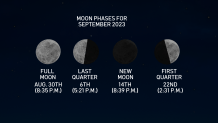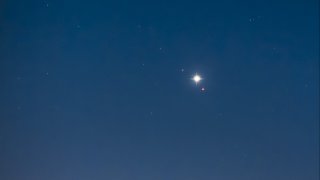
What's happening in the skies over North Texas this month? September holds some spectacular sights in the night and morning sky. Check out the list below.
PEAK OF THE ε-PERSEID METEOR SHOWER
September is not known for its meteor showers. On Sept. 9, the ε-Perseids meteor shower peaks. Despite their name, these meteors are not caused by the same comet, Swift-Tuttle, as the August Perseids. They simply appear to radiate from the same point in the night sky –which is how meteor showers get their names.
At their maximum, you can look for roughly five ε-Perseids per hour, coming from the general area of the constellation Perseus high in the southwest sky.
Get DFW local news, weather forecasts and entertainment stories to your inbox. Sign up for NBC DFW newsletters.
The ε-Perseids can be seen from anywhere in the Northern Hemisphere. You are more likely to see them if you have an unobstructed view with clear skies in a very dark place far from any urban light sources.
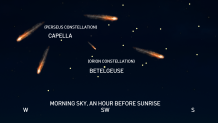
WHEN DOES THE INTERNATIONAL SPACE STATION FLY OVER NORTH TEXAS?
Local
The latest news from around North Texas.
The International Space Station will make flybys across the North Texas sky this month. The ISS appears as a fast-moving star across the night sky.
The ISS rotates around the Earth at a speed of 17,500 mph. The ISS rotates about its center of mass at a rate of about four degrees per minute so that it will complete a full rotation once per orbit. This allows it to keep its belly towards the Earth. One revolution around the planet takes about 90 minutes (16 per day).
Also, the ISS sits at an altitude of 250 miles above the Earth. By the way, that is 1.32 million feet. Most commercial airplanes fly between 33,000 to 42,000 feet.
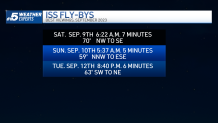
THE BRIGHTNESS OF VENUS
If you're driving in the morning, a bright object will appear in the eastern sky before sunrise. Guess what...it is Venus.
This is because Venus is reaching its greatest brightness on September 19th. This is the brightest Venus will be in the morning sky before it starts to swing back toward the Sun and eventually appear in the evening skies again.
Venus's distance from the Earth varies from 24 million miles to 162 million miles. Mars averages a distance from the Earth of 140 million miles. The closest recorded distance to Mars from Earth was recorded in August 2003 when the two were 34.8 million miles apart. According to NASA, the two will not be that close again until the year 2237.
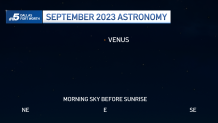
THE SEPTEMBER EQUINOX
On Sept. 23 the seasons officially change. The September Equinox is also called the Autumnal Equinox in the Northern Hemisphere and the Vernal Equinox in the Southern Hemisphere.
It signals the point where the Earth experiences roughly equal lengths of day and night. Also, this will mark the beginning of fall in the Northern Hemisphere and spring in the Southern Hemisphere.
With the passing of the September Equinox, the Earth has traveled 438 million miles around the Sun. The Earth is moving at an orbital speed of 66,616 mph. This speed is fast enough to cover the planet's diameter in 7 minutes and the distance to the Moon in 4 hours.
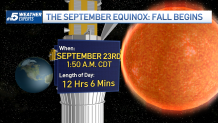
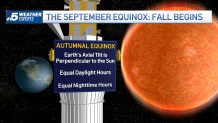
THE MORNING PEAK OF MERCURY
The month will end with a viewing opportunity of the smallest and closest planet to the Sun, Mercury. Since Mercury is so close to the Sun, we can only observe it when it reaches its furthest point from the Sun. This occurs cyclically as part of Mercury’s 88-day orbit.
On the morning of Sept. 23, you'll be able to see the planet about 16 degrees above the eastern horizon just before sunrise.
Mercury is 48 million miles away from Earth when they are at their closest. The maximum distance between the two when they are on opposite ends of their orbits is 137 million miles.
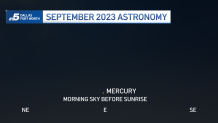
MOON PHASES
Also, check out other phases of the moon this month.
On Sept. 27 at 7:59 p.m. CDT., the moon will be at perigee, it is closest to the Earth for this orbit at 223,639 miles.
On Sept. 12 at 10:42 a.m. CDT., the moon will be at apogee, its farthest from the Earth for this orbit at 252,457 miles.
